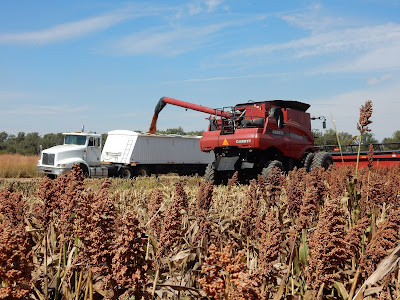
 |
| August 20, 2016 |
 |
| August 20, 2016 |


When I went to the milo field to take photos of harvest, I noticed all the ladybugs. They were feasting on the aphids.
The tiny aphids migrate on southern winds, pierce the leaves of sorghum plants, suck out the sap and excrete a sticky substance known as honeydew that will gum up harvesting equipment such as combines and ensilage cutters.
As Randy moved through the fields, you could see the sticky residue, making the milo leaves glisten. Thankfully, it didn't gum up the combine for us.
A custom harvester who was eating breakfast in town last week said he'd told his customers that he wouldn't cut aphid-infested fields without them being sprayed because he didn't want to tear up his equipment. It's kind of a Catch-22. Choosing whether or not to spray comes down to a couple of factors: economics and harvestability. It can cost between $15 and $25 an acre to spray the insecticide. Also, there's a four-week withdrawal time before it can be harvested. With milo only at $2.57 a bushel, it's not easy to make a decision to add additional expenses to production of the crop.
“Right now, with the price of sorghum, you need 90 to 100 bushels just to break even,” said J.P. Michaud, entomologist at the K-State Agricultural Research Center in Hays.In the photo above, the little dots on the combine windshield are ladybugs. They were taking a ride as Randy went through the field.
One field of our milo made 90 bushels per acre. The other field averaged 60 bushels per acre.
In 2014, Kansas ranked first in grain sorghum production in the U.S. with more than 200 million bushels grown, which equated to more than 40 percent of the country's total production.
The use of sorghum for human consumption is being developed further in countries where malnutrition and hunger are prevalent. The fall issue of the Kansas State University College of Agriculture Ag Report had an article about sorghum:
In the Mara Region of Tanzania, one of the most starved areas of the world, K-State grain scientist Sajid Alavi is part of a research team working to improve child nutrition and health by providing a sorghum-soybean porridge blend to children younger than 5. ... While the results of the five-month study are yet to be finalized, Alavi said the early indications are that children were more healthy and had average growth rates.
Even closer to home, Stafford High School students are researching milo. A post to the Stafford High School Greenhouse and Aquaponics page last week showed a photo and explained research being done by students at our small, 1A school. (That makes me really proud of our school!)
 |
| From the Stafford High School Greenhouse and Aquaponics Facebook page |
Last night, Luke Alpers and his teacher Mike Cargill spoke at a PEO gathering. Luke has been selected to represent the state of Kansas as a delegate to the 2016 Global Youth Institute in Des Moines, Iowa, October 12-15. He'll be part of the conversation with the World Food Organization about world food security. Luke will present his paper on the aquaponic system at Stafford High School.The Ag Research class has begun to investigate sorghum as an alternative to corn production in arid regions of the world. Sorghum isn't nearly as thirsty or hungry as corn, yet produces a grain seed with 95% the nutritional value of corn (lacking vitamin A). We soaked locally grown sorghum in water overnight, next morning brought the container to a rolling boil, then let it simmer for almost 2 hours. The sorghum berries where soft and tender ready to be eaten. Compared to beans, sorghum would save preparation time and save limited resources while providing a nutritious replacement for beans. The sorghum grown in the most of the US is for feed.
The SHS students are also doing experiments with mealworms.These insects were able to utilize non-food products - like Styrofoam, cardboard, banana leaves and cut-up plastic milk cartons - and convert the media into a biological food source. The worms could provide another protein source for malnourished countries and could also have implications at landfills. It is fascinating stuff! Want to know more about what our SHS students are doing? "Like" the Stafford High School Greenhouse and Aquaponics on Facebook for periodic updates on what's going on in the greenhouse and in the Ag Research class.





I've only ever heard of milo...never seen it or knew anything about it really, until I saw your header picture a few weeks ago! It really is pretty! Thankfully those nasty aphids didn't mess up your combine!
ReplyDeleteYes, we were glad, too!
DeleteSo much to digest [pun wasn't intended] in this post. So glad the lady birds have a positive role and that the aphids didn't cause damage to the harvester. Wonderful to read of Luke and SHS students and their research.
ReplyDeleteOur small school has so many opportunities for students. We are so fortunate.
DeleteKim,
ReplyDeleteWow, neat post about milo! I always enjoy your ability to share and explain the farming side of ag. We are lucky to have Land Grand Universities and scientists interested and able to do research on less common crops and how they can be utilized in many capacities.
My Grandpa raised milo.
Thank you, Robyn! Yes, I agree that land grant universities provide valuable tools for agriculture (and other industries, too). Just another reason to love my alma mater!
Delete